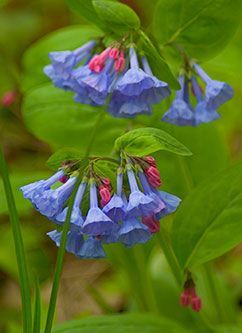I have a small colony of Virginia bluebells and love them. The roots were given to me by a lady with a huge wildflower garden.
This North American woodland native is a worthy and care-free addition to any shady wildflower or naturalized area, and undisturbed plantings will slowly increase in size.
The lush green foliage appears seemingly overnight in early spring. Pink buds quickly grow into nodding clusters of glorious sky blue bells, sharing the to-die-for blue color of forget-me-not (Myosotis), borage and other borage family members.
Growing tips

Virginia bluebells
iStockphoto
Mertensia is native to the eastern half of the United States and Canada, and is hardy in Zones 3 to 9.
This wildflower grows about 1 to 2 feet tall, and the flowers appear about the same time that bloodroot (Sanguinaria) is in bloom.
These two woodland natives make a nice combination.
Care after blooming
The most important thing to understand is that like spring bulbs, the plants fade away after blooming, but they do it quickly (their leaves don’t linger like tulip foliage does).
The trick is to plant them with other perennials that will fill the gaps.Christmas fern (Polystichum acrostichoides) foamflowers (Tiarella),hostas, or other shade garden residents will rapidly fill the space.
Because this perennial is so ephemeral, plant it where you won’t be tempted to dig repeatedly as you might forget it is there and destroy the roots. Propagate by seed – the plants will self-seed if they are happy in your garden – or you can divide them by digging up the roots in early spring.
More Garden Info
More tips for gardening in the shade
Blue indigo – another lovely blue-flowering native perennial
Native wildflowers for sunny gardens







